[/caption]
Antarctica’s distinctive, unforgiving environment is truly unique. But add to that setting the otherworldly task of looking for meteorites — bits and pieces from the far reaches of our solar system that are strewn about Antarctica’s icy surface,– and Earth’s southern-most continent can provide a truly unparalleled scientific experience. “I had the privilege to explore a part of the world that few people get to,” said Dr. Lucy McFadden, a research professor in the astronomy department at the University of Maryland, College Park. She also is a scientist in the education and public outreach area for NASA’s Dawn mission that is traveling to study the asteroids Ceres and Vesta. McFadden had the opportunity to travel to Antarctica and spend over six weeks hunting for meteorites, specifically looking for meteorites from Ceres and Vesta. She shared her experiences recently in an online “webinar,” answering questions about her journey. “I love sharing my adventures,” she said. “My excitement about exploring the solar system was renewed because I had the opportunity to explore Earth as a planet.”
Although meteorites fall uniformly all over the Earth –estimates are between 30-80 tons a year, — most are in the form of dust. For the bigger rock-sized pieces, many fall in the ocean and those that fall on land can be buried by shifting terrain, broken down by chemical weathering, or are easily confused with Earth rocks. But Antarctica’s blue ice sheets are clear and barren, making it easy to spy a dark rock that’s likely a sample from space.
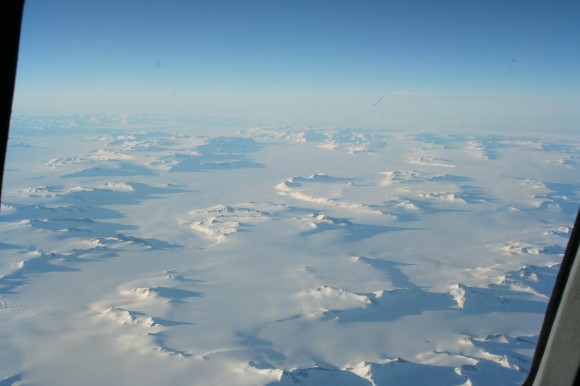
However, there’s another reason Antarctica is such a great place to look for meteorites. “There’s something special about Antarctica. Meteorites collect in certain areas there,” McFadden said. “The ice sheets are always moving, and the meteorites move with them. But the rocks get trapped by the barriers of the mountains, and that’s where the meteorites are found. Once you get a meteorite up against a barrier, the constant blowing of the polar winds ablates the ice, and rocks effectively come to the surface.” Over periods of tens or hundreds of thousands of years, very significant concentrations can build up in these areas.
Since 1976, the U.S. National Science Foundation has supported an annual search for meteorites during the Antarctic summer, through a program called ANSMET, the Antarctic Search for Meteorites. McFadden was part of an eight-member meteorite hunting team in November 2007 to January 2008.
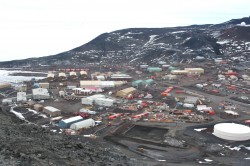
A C-17 cargo plane brought the team to Antarctica’s McMurdo Station. But one doesn’t just go out and start hunting for rocks without instructions on how to survive Antarctica’s harsh environment. The team underwent a week of training that included lessons on proper clothing. “I had to learn which coat to put on when, which hat and gloves to wear and be sure to have my boots on,” said McFadden. “It brought me back to kindergarten.” Also, learning snowmobile operation and repair is a must, as that would be their mode of transportation during their expeditions. “We were trained how to stay away from the crevasses in the ice and trained for rescue in case someone fell in,” she said.
A plane then brought the team, the snowmobiles, fuel and gear to their field site on the Miller Range to set up camp. They erected tents – their homes for six weeks, and had to chip ice to get water for drinking and cooking. Typical daytime temperature was about 20 degrees Fahrenheit (-6 C) when there wasn’t a storm.
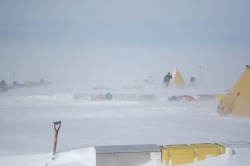
At 70 degrees south latitude, the Antarctic summer sun never set. But the surroundings were desolate, to say the least. The region is mountainous, but constantly snow and ice covered. “I felt a sense of vulnerability of us humans,” McFadden said. “This is not a hospitable environment.” She also worried about the possibility of getting lost in the barren landscape with few landmarks. But with them was a seasoned, expert guide, John Schutt.
So what’s the trick of finding meteorites in Antarctica? “We practiced around the camp first, and walked up to all the rocks in the area,” said McFadden. “There are other rocks on the ground from rockslides from the mountains, so you have to learn what the local rocks look like.” Dr. Ralph Harvey, the head of the ANSMET program taught the team the art of meteorite hunting.
“When you find a field of rocks, you have to look closely and separate out the regular rocks from meteorites,” McFadden said. Most meteorites are black because they have a fusion crust: a thin glassy rind that forms on meteorites when they are coming through the atmosphere. The friction heats them up and the outside of the meteorite melts just a little.
“We looked at each rock,” said McFadden. “If we thought we found a meteorite, we waved our arms and everyone would come over and look. If we determined it was a meteorite, we would pick it up with tongs and put it in a Teflon bag and mark it. Then we planted a flag where we found a meteorite. It was very satisfying to look back where we’d been and see all the flags.”

They followed a certain procedure to make notes on each meteorite, take pictures, note the position of each sample with a Global Positioning System monitor, and then wrap the meteorites in a certain way and put them in backpacks. “It was a big process to catalogue and account for all of them,” McFadden said.
At the end of the day they collected all the rocks from the backpacks and put them in bags in a specialized container to keep them cold. This would avoid contamination from any snow that might be attached to the rocks, until they are brought to Johnson Space Center where they are catalogued and then distributed to scientists around the world.
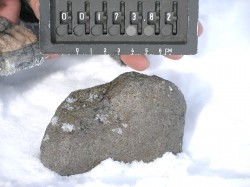
Each of the meteorites tells a story about the processes of the early solar system. Scientists who study meteorites can find clues to the conditions as our solar system evolved, and find out more about the asteroids, moons and planets the meteorites originate from. Meteorites represent a “free” sample return mission for scientists.
The team didn’t do any scientific analysis out in the field, just collected the samples for transport to the laboratories in Houston. But that doesn’t mean they didn’t examine the rocks!
The team found lots of carbonaceous chondrites with very irregular and jagged shapes, some that may have come from the Moon, and others with a green mineral called olivine that may have come from Mars. One meteorite found made the team think of the famous ALH 84001 meteorite found in the Allan Hills region of Antarctica, that made headlines in 1996 when it was announced that the meteorite may contain evidence for traces of life from Mars. “We wondered if this one meteorite was related to ALH 84001,” said McFadden. But the team won’t know the answer until geochemical analyses are performed.
As for her search for samples from Ceres and Vesta, McFadden said, “I think we might have been successful in finding samples from Vesta, but I was really interested in looking for samples from Ceres. However, I wasn’t really sure what I was looking for. As far as we know we don’t have samples from Ceres.”
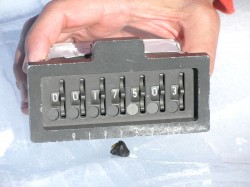
How do scientists know a meteorite came from a specific asteroid? “The whole study of meteoritics addresses that through laboratory studies of many different attributes of rocks,” said McFadden. “We know we have rocks in our meteorite collection from Vesta because about one in every seven meteorites we find has characteristics, or spectral signature, that matches Vesta as viewed through a telescope. We look at Vesta and see a huge impact basin that the meteorites probably came from.”
But Ceres is a different matter. “We don’t know much about Ceres,” she said. “The spectral signature of Ceres doesn’t match anything we have in the meteorite collection. But maybe they’ll find one in the samples we brought back or eventually find one on a future expedition.”
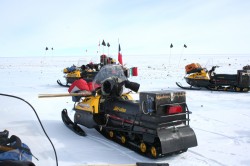
With stormy periods when they had to huddle in their tents, McFadden’s team had 22 full days of meteorite searching, and eight half days. They went out at 9:00 am, returning at 5:00 pm. “We had six guys and two women,” said McFadden. It’s different for each expedition. We didn’t know each other before hand, but we worked well together. We had this common experience and we had to look out for each other. But it was also very lonely; there wasn’t that much opportunity to interact. We were exhausted each night.”
They did have opportunities for recreation such as skiing, playing games or reading books. One particularly nice day they made a couch from snow and sat outside for awhile. Planes occasionally brought re-supply of food, letters, and other supplies. They were in Antarctica for Christmas, so they decorated and had a potluck supper. “The isolation and cold weather got to us after awhile, but we loved our time out there,” McFadden said. “We looked forward to going home, but we had a tremendous experience. We all appreciated the beauty of Antarctica.”
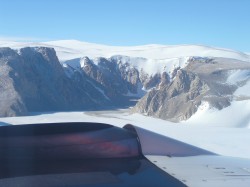
Their expedition found 710 meteorites, some as small as a little finger nail (about 1.0 x 0.5 x 0.5 cm) 3a), and others about 8 pounds and too big to hold in one hand (about 25 cm x 15 cm x 12).
“We had good hunting,” she said. “It wasn’t a record. Some days we wanted to keep going, but our guide had to keep us in check and keep us safe. In that climate you do have to stop and take care of yourself.”
Over the more than 25 years of these expeditions, over 26,000 meteorites have been found, expanding the volume of extraterrestrial materials that can be studied here on Earth to provide a context for our remote sensing explorations out in the solar system, such as the Dawn mission. “My experience searching for meteorites inspired me to continue trying to understand the meteorites themselves and pair that with my exploration with the Dawn spacecraft that is searching out in the solar system,” said McFadden.
And now another team of scientists is preparing to return to Antarctica in November this year to continue the hunt.
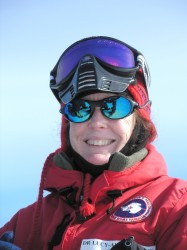
McFadden responded to the question of why teams keep going back every year to look for meteorites. “There is the potential to find new types of meteorites. In 2006, they found a type of meteorite that had never been seen before. They believe it’s from another body in our solar system that was probably the size of the moon, but its isotopic signature is decidedly different from the moon or Mars. So we have indeed found evidence of planetesimals that are new to us that are out there in the asteroid belt. That’s very exciting and that keeps us going.”
More information:
McFadden’s article on the Dawn website.
McFadden’s video “webinar” presentation.
“Find a Meteorite” online activity
Dawn Mission website
Dawn Mission Education website

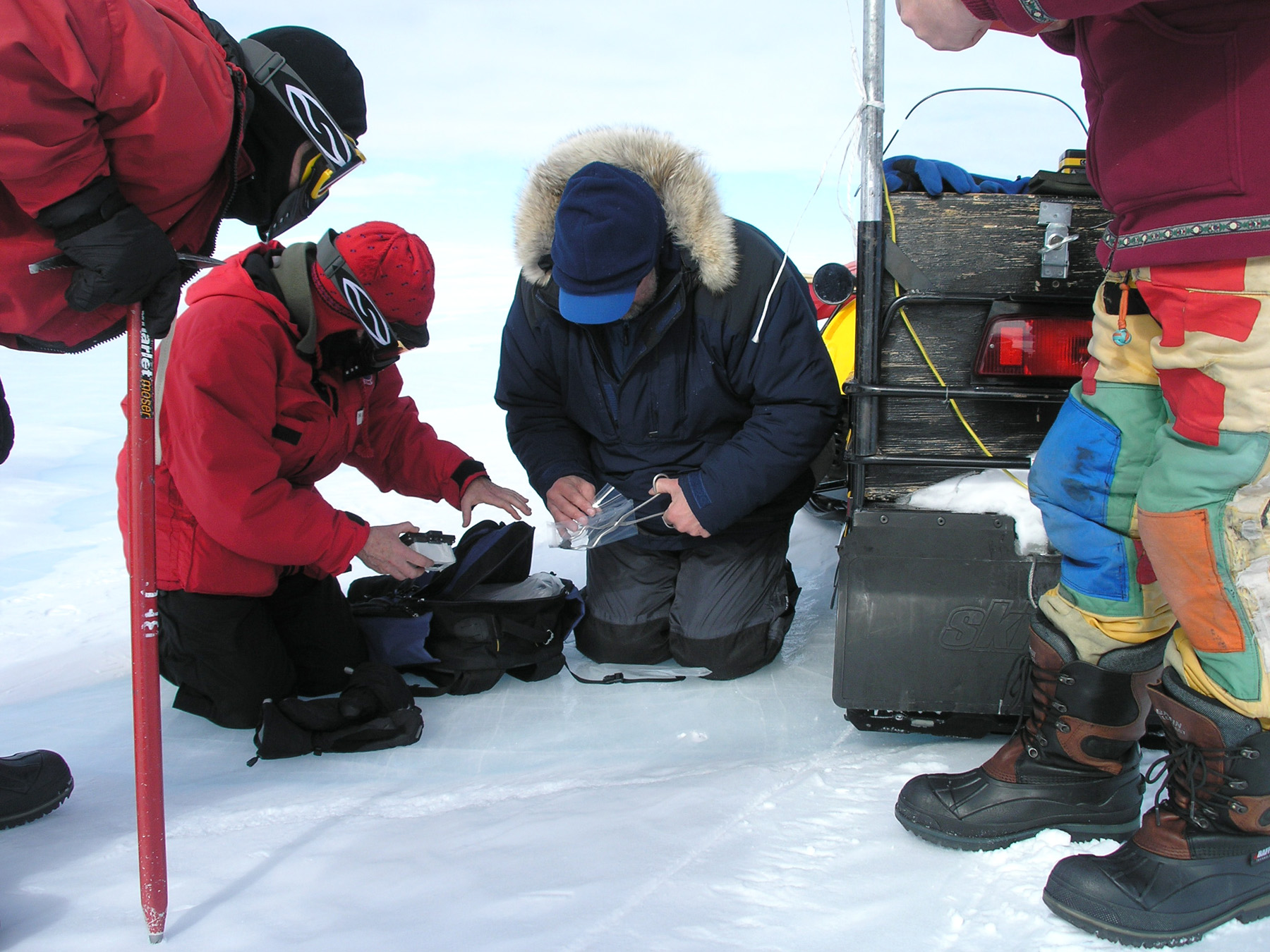
every night i look up and wish one would land next to me just not on me you are very lucky to have the job you have would you like to swap jobs i work nights in a freezer guess not lol
Hmm…
This is about Science, how about using proper units like Celsius – it is not only scientific, but what most people on the planet Earth are familiar with.
I actually learnt most about the MKS units from an American physics text book at school in New Zealand over 40 years ago.
Me and my youngest son visited the Antarctic centre in Christchurch last year.
When he was 6, I helped him improve his reading age to 8+ by reading books on space & astronomy aimed at 8-14 year old’s.
*Gavin*
Celsius is scientific? Really?
So what is so scientific about ranting on about the precocious upbringing of your child?
While I’m at it, before nitpicking at a finely written article please look to ones own front door – ‘Me and my youngest son’ – shouldn’t that be ‘My youngest son and I’? It’s what most people on Earth are familiar with after all!
Gavin, are you new to science? Celcius is not the reigning unit of measure for temperature. There isn’t one. Which one you use depends on the actual range and detail you need. If you need more detail farenheit is actually better.
Secondly, she gave BOTH… so it isn’t like you had to break your brain doing a conversion.
Third, most scientists don’t even try to convert between the measurements.. they know whether you say 20C or 70F it is “comfortable and habitable” for instance.
Forth, you complain about this being science yet you go into a couple of non-science tangents.
Fifth, get your own blog and then you can complain and set definite rules. Here it is a normal blog, and considered informal. Grammar and spelling police can go elsewhere. If it doesn’t affect the content, then deal with it.
Sixth, somebody stop me.
How does it feel when someone is critical and nit-pickey about what you write? THINK!
i would be jail by now if the spelling police was about
see lol
Imperial units mean nothing to me. (Yes European)
But still I wouldn’t bitch about them, Our American friends will catch up with the rest of the world some day
Back to the article, (Which was a wonderful read)
I would love to be down south right now looking for meteorites, or any reason would do to be down in the Antarctic. Must go back some day.